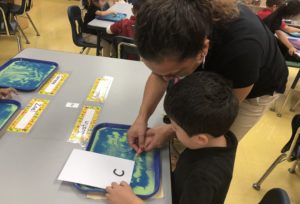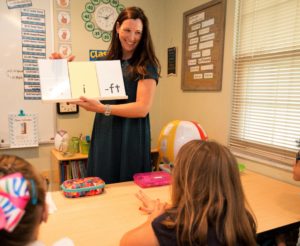Administering a variety of reading assessments is an integral part of instruction. It allows teachers to take an active role in making decisions about the goals of instruction and the content of learning.
Assessments provide information that is fundamental in helping teachers to determine what to teach and how to teach it, while answering the critical question, “Are my students learning?” Thoughtful reading assessment allows teachers to maximize their time and focus on matching instruction and content to goals. When an assessment is directly aligned with instruction, both the teacher and the students benefit.
Reading assessments come in many forms and can serve a myriad of purposes. They are multi-faceted and may be formal or informal. They help us to analyze the learner’s performance, both quantitative and qualitative, as it represents both product (what the student has learned) and the process (how the student learns best).

As they lead their students on the marathon of learning, it is essential for teachers to establish the start line, the finish, and plan for frequent “checkpoints” along the way. In an effort to provide for thorough and thoughtful assessment, teachers will want to prepare a compilation of assessments that provide direct answers to their questions about student learning and drive their important decisions about instruction.
There are a various types of assessments and teachers will want to consider them all when planning for the year.
Diagnostic Reading Assessment
The diagnostic assessment is administered at the beginning of a unit or lesson as a pre-test. This form of assessment allows for the educator to gauge the student’s pre-knowledge and answers the question “How much does this student already know about this (subject area, topic, content)?” Diagnostic assessment provides information about the student’s strengths and areas of weakness.
Results can guide the teacher’s development of learning objectives, lesson planning, and identification of concepts that are in need of review. When followed by a post-test, the teacher will be able to see how much knowledge the student has gained during the instructional period. The comparison of pre and post-test results can also support the efficacy of instructional methods and when shared with students, can serve as a critical tool to build their self-esteem.
Formative Reading Assessment
The formative assessment is given during the midst of the learning process and provides the teacher with actionable, real-time feedback that serves many purposes. The word formative comes from the Latin “formare,” which means to form or shape.
This reading assessment indicates how the students are learning and how the teacher is teaching. Easy and quick to implement, the formative assessment yields powerful information to drive instruction. Results will help the teacher to form or shape the instruction to come. Formative assessments may be conducted daily or weekly to allow for the teacher to engage in continuous adjustments to instruction to match the students needs.
Consider the formative assessment like a frequent “check-up” that is necessary to ensure that learning is on a just-right track for every student. The results directly guide the teacher to make critical decisions about differentiation and can help to place students into groupings to enhance learning. Formative assessment answers a variety of important questions:
- What did my students take away from this lesson?
- Did my teaching strategy reach the students effectively?
- What are common errors? What are individual errors?
- Did I succeed in teaching to my target goals?
- Where do I go next with instruction?
Interim Reading Assessment
The interim reading assessment analyzes the overall performance of a larger group or population (grade, school, District). This assessment is administered at specific times of the year and allows for teachers and administrators to track student progress. Interim checks can help to guide decisions regarding the overall effectiveness of instructional content, methods, and general accountability.
Summative Reading Assessment
The summative reading assessment is administered at the end of a specified instructional period. It answers the question “How effective was instruction?” Results allow educators to see how much content was retained by the students. This assessment can also support teachers and administrators to reflect on instructional practices and review content to inform decisions for the future.
Teaching to the “sweet spot”
Assessment can also help us to identify the learner’s zone of proximal development (ZPD). This zone outlines the skills that may be too difficult for the student to master on his own, but have great potential for mastery with guidance and modeling from a knowledgeable instructor.
The ZPD is often referred to as the “sweet spot” of learning. Assessment plays a key role in targeting the ZPD for students. When assessment is left out, instruction is at risk for being below the ZPD or above the ZPD. When combined with clear target skills and learning outcomes, assessments allow teachers to isolate the skills that need support while planning meaningful instruction for all learners. Some ways that assessment can drive instruction to mastery of skills in the ZPD include:
- Ask a student to answer the question “How do you know?” In spelling dictation, this gives the student an opportunity to use concept knowledge to explain the spelling rule, pattern, or position that is applied in a word.
- Modeling “how to” provides the student with opportunities to spell a similar word or apply similar rules or strategies to spelling.
- Putting students in small groups or a pair to share and have them discuss a new concept, review a rules notebook, or discuss multiple spellings before initiating practice.
- Using visual aids to help students conceptualize a concept, such as hand gestures for morpheme identification, rules posters, or mnemonics.
- Asking students to use prior knowledge to better understand more complex concepts.
- Walking students through the self-editing process to activate strategies to check for accuracy and understanding.
All too often, it is easy to get caught up in the data that is generated from reading assessments. However, teachers should recognize the value of implementing frequent and varied assessments. These tools can tell us a great deal about the trajectory of learning for each student from day to day and year to year.
Some instruction is cyclical and will resurface topics such as parts of speech, grammar usage, and writing mechanics from one year to the next. Assessment can help to determine if students are retaining content that has been revisited over time. Other knowledge stacks like building blocks, allow learners to link new knowledge to existing information in ways that make sense to them.
Educators need to give careful consideration to ensure that reading assessments are not administered for the sole purpose of emphasizing outcomes. The benefits of assessment are immense. Above all else, it can also measure the effectiveness of learning strategies and provide vital information about the student’s responsiveness to teaching, future learning potential, and instructional needs.
About the Author
 Dr. Kirstina Ordetx is a Level 4 Master Instructor with The Institute for Multi-Sensory Education (IMSE). She holds a doctorate in Counseling Psychology with a concentration in pediatric neurology. Dr. Ordetx is an educational specialist with over 25 years of clinical experience, research, and consultation. She is a certified Structured Literacy Dyslexia Interventionist through the Center for Effective Reading Instruction, a Certified Nutrition and Wellness Consultant, Executive Functions Coach, and a registered Licensed Mental Health Intern. Dr. Ordetx has published two books that compile her research and practice in Theory of Mind. She has served on accreditation committees for the Florida Council of Independent Schools, is a university adjunct professor in developmental and child psychology, and presents at various national and international conferences. Dr. Ordetx is head of school for a private academy in Lakewood Ranch, Florida specializing in the multi-sensory education of students who have language and learning-based differences. She is the Executive Director of the Pinnacle Pediatric Therapy Group, a multi-disciplinary, pediatric therapy clinic.
Dr. Kirstina Ordetx is a Level 4 Master Instructor with The Institute for Multi-Sensory Education (IMSE). She holds a doctorate in Counseling Psychology with a concentration in pediatric neurology. Dr. Ordetx is an educational specialist with over 25 years of clinical experience, research, and consultation. She is a certified Structured Literacy Dyslexia Interventionist through the Center for Effective Reading Instruction, a Certified Nutrition and Wellness Consultant, Executive Functions Coach, and a registered Licensed Mental Health Intern. Dr. Ordetx has published two books that compile her research and practice in Theory of Mind. She has served on accreditation committees for the Florida Council of Independent Schools, is a university adjunct professor in developmental and child psychology, and presents at various national and international conferences. Dr. Ordetx is head of school for a private academy in Lakewood Ranch, Florida specializing in the multi-sensory education of students who have language and learning-based differences. She is the Executive Director of the Pinnacle Pediatric Therapy Group, a multi-disciplinary, pediatric therapy clinic.
Sign up for our LIVE virtual Orton-Gillingham training! We are now offering half-day, evening, and weekend options to best fit your schedule.
The IMSE approach allows teachers to incorporate the five components essential to an effective reading program into their daily lessons: phonemic awareness, phonics, vocabulary, fluency, and comprehension.
The approach is based on the Orton-Gillingham methodology and focuses on explicit, direct instruction that is sequential, structured, and multi-sensory.
It is IMSE’s mission that all children must have the ability to read to fully realize their potential. We are committed to providing teachers with the knowledge and tools to prepare future minds.
Please connect with us on Facebook, Twitter, and Pinterest to get tips and tricks from your peers and us. Read the IMSE Journal to hear success stories from other schools and districts, and be sure to read the OG Weekly email series for refreshers and tips.

